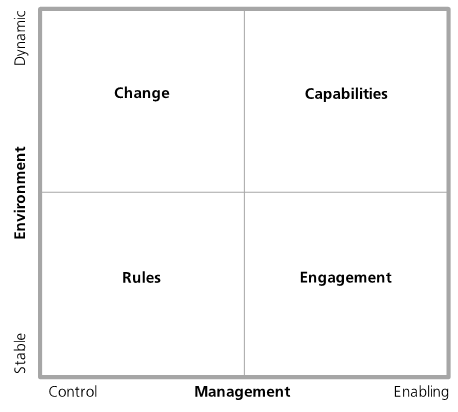Once upon a time you had some clue what your business environment was. Most of the ways in which you explored your environment and tried to deal with the pressures of competitors, customers, pricing et cetera were relatively static. That gives us quite a lot of certainty in our planning, and any new things we bring to the firm in terms of new products or innovations can be accommodated reasonably easily.
Faster, faster!
But now we live in a much faster moving environment. It seems as though everything is changing all the time and we have to cope. All the parameters we work with are quite elastic with timeframes that are much shorter and so we need new ways of describing how our firm works. We may hanker for a simpler time. But however much we yearn for it, we know it won’t happen, and things may become even more uncertain.
It’s called a VUCA world – volatile, uncertain, complex, and ambiguous. We need ways of navigating it. It is easy enough to grab a new business book, and wonder if this is the Holy Grail for you. Unlikely, as your context will not be the writer’s. First ask yourself – do you need to change?
Do you need to change?
We have a number of clients who are in fast moving environments, but we have some who aren’t. They have changes that they have to accommodate, but they do not need to throw the baby out with the bathwater. Which are you?
Your business probably sits somewhere in the four quadrants below. If you are in a fairly stable environment you might have adopted a rules-based management system because things aren’t changing too fast. That’s one where you can use set procedures and methods which your people can use repeatedly. If you’re in a dynamic environment, perhaps a creative agency, where every service or product is tailored to a customer, you may want to use the full capabilities of your employees by enabling them as much as possible. A change based environment assumes you are in a market driven environment where there is a need to respond rapidly to competitive or market changes, such as regular launches of new features or products. You will have procedures for doing this, as your products won’t be tailored to each customer.
Why wouldn’t you want to do use your people’s full capabilities anyway? Employee engagement is a very fashionable concept at the moment, and the way in which most firms try to achieve this. Yet studies show that most employee engagement programs don’t produce much tangible benefit. Engagement works with an enabling management style, but won’t get you all the way to using full capabilities, as it’s the management style of the firm and its environment that matters. Employee engagement works (to a point) if your environment is relatively stable. It works quite well if you want to take a step back, and change your work life balance, so that yours becomes a lifestyle business. That works if your business is in a stable environment. But it’s not enough if it is in a dynamic environment as well. The quadrant shows that if you need to move from a rule-based environment to change or capability based environment employee engagement by itself is unlikely solve this issue for you. Fashionable isn’t always appropriate.
How can you use these quadrants?
Regularly sense check where you are now and where you think you may have to, or indeed wish to, move. You can see what sort of management system and roles might help with that. The quadrants also give you some clue as to what elements you might have to change to accomplish your goals. Without this, you run the risk of being unaware of a change in environment which your competitors or market has adopted so you get left behind. Or you may attempt to move into a new environment to counter such a perceived threat but using management roles which won’t work.
Sense check it with us – we have plenty of experience in tailoring systems to businesses so that you get what you want. It is, after all #AllAboutYou.
With thanks to Agility Insights for the use of their quadrant model

